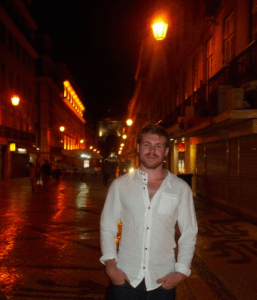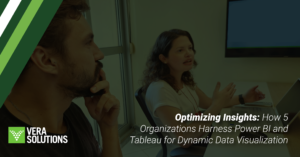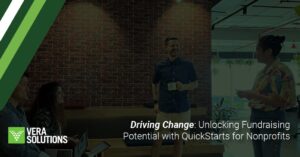Christian Paré is a Senior Consultant for Vera Solutions. Prior to joining Vera’s Geneva team, Christian spent four years studying and working in the Swiss melting pot. There, he worked at several international organizations, including IOM, UNHCR, and The Global Fund, and received his Master’s degree in International Studies from the Graduate Institute.
How did you learn about Vera? What drew you to Vera?
I learned about Vera while working at an international organization in Geneva. When I had started, Vera was in the process of implementing a monitoring and evaluation (M&E) system, and I had a chance to provide my input on what would ultimately be the final product delivered in part by Vera.
Throughout the implementation, the Vera team members that I worked with were excellent solution architects and quick to learn our complex business processes, provide feedback, and implement solutions. What really struck me were their fresh ideas on the problems, both large and small, that had been nagging pain points, buffeted by their ability to clearly and easily communicate these ideas in a complex, multi-cultural environment. The experience left a mark on me, and it played a large role in my decision to join Vera.
How have your interests, or background, prepared you for working at Vera?

I have always been a bit of a geek. I began building websites and playing with graphic design software at a young age. Although the 1990’s Microsoft FrontPage and Adobe Dreamweaver are a far cry away from Salesforce and platforms like it, I can say that playing a role in system design of an M&E system is just as fun as wrapping up a website was back then.
Beyond my interest in technology and user design, my studies led me towards global development somewhat organically. My undergraduate degree in History and Political Science from the University of Waterloo in Canada exposed me to some courses in development, where I met some incredible professors that sparked my curiosity in development. From there, it was natural to apply for a graduate program in Geneva, which is one of the major hubs — if not the major hub — for global development. I was fortunate enough to be accepted into the Masters program in International History at the Graduate Institute in Geneva, which provided me not only a rich academic offering, but also the opportunity to work for some interesting international organizations while completing my studies.
Partway through my studies I stumbled upon a very interesting opportunity to work with an organization specializing in public health. I was immediately captured by public health as it’s an interesting thought space where people from many disciplines work together to provide good, cost-effective solutions to some very important problems that burden many people’s daily lives. Coming from a multi-disciplinary background, this was an obvious fit for me, and I felt I had room to contribute and learn on a daily basis.
Prior to joining Vera I had room – albeit not much room – to bring my interest in technology into the picture. In this sense, my background did not necessarily prepare me for Vera; rather, Vera is a good match for my interest in development, public health, and technology, combined with my academic and professional background, which I wanted to use to help clients build solutions to complex problems.
How would you characterize your interest and background in international development, data, or technology before you arrived at Vera? How would you characterize it now?
I’ve always been interested in technology, and later developed an interest in development. Prior to Vera, I was exploring the intersection of the two. In one of my roles, I was weighing in heavily on the creation of a grant management system that my team was using to evaluate grant applications. Through this, I caught a glimpse of the impact that sophisticated data collection could have on strategic decisions. This drove it home for me; early on in my Geneva chapter, I worked for an international organization that could have benefited from such a system, so seeing one work was quite meaningful. Years later, and now at Vera, not much has changed; on a daily basis I’m able to see how powerful the intersection of development, data, and technology can be. As more organizations adopt an integrated systems approach, and as the technologies permitting them to do so evolve rapidly, I’m even more optimistic about what we’ll be able to do in the future.
What can small or medium size organizations learn from your experiences navigating large, international organizations?
Large international organizations are in their nature quite complex. With so many moving pieces, it is often difficult to see past the next day’s problems that need to be solved in a technology implementation. Strong leadership that can make strategic and technological decisions is necessary for the long-term. But there is also a lot that can be done on a day-to-day, granular basis to ensure the systems an organization is implementing are impactful and sustainable.
At the end of the day, one of the most important things for any organization is aiming for simplicity in system design, while striking a balance between short-term needs and long-term growth and sustainability. It is often easy to attack a problem with a short-term solution that is completely unsustainable in the long-term, leading to either compounded complexity in the future or a scrapped product that needs to be rebuilt to accommodate more varied requirements. This can come into play in decisions as small as “what should I name this field?” or as large as building out a security matrix – things that we, at Vera, encounter on a daily basis as we steward our clients through the system design and development process.
In large organizations, rolling out a data system means transitioning the many internal users onto the system, and potentially thousands of external users. It’s important to pad such large transitions with a change management plan, and, more tangibly, facilitate an inclusive design process. This means frequent (and transparent!) communication on development progress, a continuous effort to keep end users engaged, and assurance that the product will be supported in the long-term. Although we all interact with technology on a daily basis, there are widespread beliefs that new systems are a) built in a black box, b) not designed with the end user in mind, and c) bound to be bug-ridden and unsupported after release. To dispel these perceptions, honest communication and a change management plan go a long way.
When do you feel like you’re moving the needle?
In all honesty, not every day. I inherently know the value of our work in general, but what I find most gratifying is watching a user interact with a system I helped design from scratch (an achievement in itself!). What’s even more important and impactful is seeing that same system produce consistent, valuable data with an understanding of how that information is enabling that organization to be more efficient, effective, and successful in reaching their mission.



